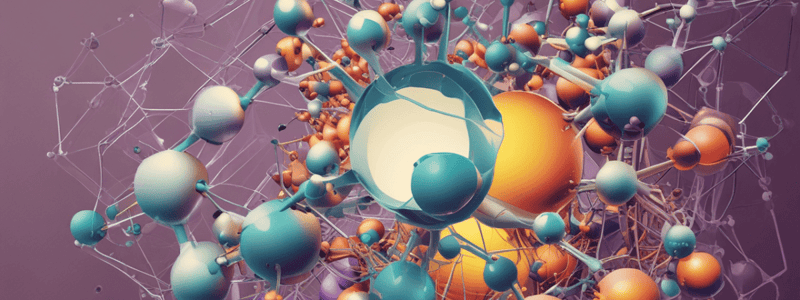Podcast
Questions and Answers
What is the result of reacting tertiary alcohols with HX?
What is the result of reacting tertiary alcohols with HX?
- Slow reaction
- Rearrangement
- No reaction
- Fast and effective reaction (correct)
Why are alternative methods used for primary and secondary alcohols?
Why are alternative methods used for primary and secondary alcohols?
- They are not used in organic chemistry
- They react very slowly and often rearrange (correct)
- They react too quickly
- They are not reactive
What is used to prepare alkyl halides from primary and secondary alcohols?
What is used to prepare alkyl halides from primary and secondary alcohols?
- HX gas
- NaOH
- H2O
- SOCl2 or PBr3 (correct)
What type of reaction do alkyl halides undergo with nucleophiles?
What type of reaction do alkyl halides undergo with nucleophiles?
What type of reaction do alkyl halides undergo with Brønsted-Lowry bases?
What type of reaction do alkyl halides undergo with Brønsted-Lowry bases?
How many components are necessary in any substitution reaction?
How many components are necessary in any substitution reaction?
What is the purpose of adding HCl or HBr gas into an ether solution of tertiary alcohol?
What is the purpose of adding HCl or HBr gas into an ether solution of tertiary alcohol?
What is formed when a tertiary alcohol reacts with HX?
What is formed when a tertiary alcohol reacts with HX?
Why are phosphorous halides used in the preparation of alkyl halides?
Why are phosphorous halides used in the preparation of alkyl halides?
What is the general term for the reaction of an alkyl halide with a nucleophile or a base?
What is the general term for the reaction of an alkyl halide with a nucleophile or a base?
What is the kinetic order of an SN2 reaction?
What is the kinetic order of an SN2 reaction?
What is the effect of bulky R groups on the SN2 reaction rate?
What is the effect of bulky R groups on the SN2 reaction rate?
Why do 3° alkyl halides not undergo SN2 reactions?
Why do 3° alkyl halides not undergo SN2 reactions?
What is the key feature of the SN1 mechanism?
What is the key feature of the SN1 mechanism?
What is the role of the nucleophile in the SN1 reaction rate?
What is the role of the nucleophile in the SN1 reaction rate?
What is the type of reaction mechanism exemplified by reaction 1?
What is the type of reaction mechanism exemplified by reaction 1?
What is the effect of the number of R groups on the carbon with the leaving group on the SN2 reaction rate?
What is the effect of the number of R groups on the carbon with the leaving group on the SN2 reaction rate?
What is the reactivity of methyl and 1° alkyl halides in SN2 reactions?
What is the reactivity of methyl and 1° alkyl halides in SN2 reactions?
What is the kinetic order of an SN1 reaction?
What is the kinetic order of an SN1 reaction?
What is the characteristic of the reaction site in an SN2 reaction?
What is the characteristic of the reaction site in an SN2 reaction?
What is the most common type of base used in elimination reactions?
What is the most common type of base used in elimination reactions?
How do you identify the α carbon in an elimination reaction?
How do you identify the α carbon in an elimination reaction?
What is the result of removing the elements of H and X from the α and β carbons in an elimination reaction?
What is the result of removing the elements of H and X from the α and β carbons in an elimination reaction?
How many mechanisms of elimination are there?
How many mechanisms of elimination are there?
What is the name of the bimolecular elimination mechanism?
What is the name of the bimolecular elimination mechanism?
What is the name of the unimolecular elimination mechanism?
What is the name of the unimolecular elimination mechanism?
What is the relationship between the E2 and SN2 mechanisms?
What is the relationship between the E2 and SN2 mechanisms?
What is the relationship between the E1 and SN1 mechanisms?
What is the relationship between the E1 and SN1 mechanisms?
What is the first step in drawing the product of dehydrohalogenation?
What is the first step in drawing the product of dehydrohalogenation?
What is the purpose of identifying the β carbon in an elimination reaction?
What is the purpose of identifying the β carbon in an elimination reaction?
I¯ is a good nucleophile and a strong base.
I¯ is a good nucleophile and a strong base.
DBU is a bulky nucleophilic base that favors substitution.
DBU is a bulky nucleophilic base that favors substitution.
CH3COO¯ is a strong base that favors elimination.
CH3COO¯ is a strong base that favors elimination.
KOC(CH3)3 is a good nucleophile that favors substitution.
KOC(CH3)3 is a good nucleophile that favors substitution.
Tertiary alcohols react with HX to form alkyl halides.
Tertiary alcohols react with HX to form alkyl halides.
Bulky R groups increase the SN2 reaction rate.
Bulky R groups increase the SN2 reaction rate.
E2 reactions involve the formation of a carbocation intermediate.
E2 reactions involve the formation of a carbocation intermediate.
HS¯ is a weak base that favors substitution.
HS¯ is a weak base that favors substitution.
DBN is a good nucleophile that favors substitution.
DBN is a good nucleophile that favors substitution.
Br¯ is a strong base that favors elimination.
Br¯ is a strong base that favors elimination.
Flashcards
Alkyl Halide
Alkyl Halide
An organic molecule with a halogen bonded to an sp3 hybridized carbon.
Primary Alkyl Halide
Primary Alkyl Halide
Alkyl halide with one carbon attached to the carbon with the halogen.
Secondary Alkyl Halide
Secondary Alkyl Halide
Alkyl halide with two carbons attached to the halogen carbon.
Tertiary Alkyl Halide
Tertiary Alkyl Halide
Signup and view all the flashcards
Vinyl Halide
Vinyl Halide
Signup and view all the flashcards
Aryl Halide
Aryl Halide
Signup and view all the flashcards
Allylic Halide
Allylic Halide
Signup and view all the flashcards
Benzylic Halide
Benzylic Halide
Signup and view all the flashcards
Common Name
Common Name
Signup and view all the flashcards
Polarity
Polarity
Signup and view all the flashcards
Nucleophile
Nucleophile
Signup and view all the flashcards
SN2 Mechanism
SN2 Mechanism
Signup and view all the flashcards
SN1 Mechanism
SN1 Mechanism
Signup and view all the flashcards
Leaving Group
Leaving Group
Signup and view all the flashcards
Carbocation
Carbocation
Signup and view all the flashcards
Reaction Kinetics
Reaction Kinetics
Signup and view all the flashcards
Substitution Reaction
Substitution Reaction
Signup and view all the flashcards
Elimination Reaction
Elimination Reaction
Signup and view all the flashcards
Halothane
Halothane
Signup and view all the flashcards
Steric Hindrance
Steric Hindrance
Signup and view all the flashcards
Radical Halogenation
Radical Halogenation
Signup and view all the flashcards
Addition Reaction
Addition Reaction
Signup and view all the flashcards
Study Notes
Alkyl Halides
- Alkyl halides are organic molecules containing a halogen atom bonded to an sp3 hybridized carbon atom.
- The halogen atom is often denoted by the symbol X.
- Alkyl halides are classified as primary (1°), secondary (2°), or tertiary (3°), depending on the number of carbons bonded to the carbon with the halogen atom.
Types of Alkyl Halides
- Vinyl halides have a halogen atom bonded to a C-C double bond.
- Aryl halides have a halogen atom bonded to a benzene ring.
- Allylic halides have X bonded to the carbon atom adjacent to a C-C double bond.
- Benzylic halides have X bonded to the carbon atom adjacent to a benzene ring.
Nomenclature of Alkyl Halides
- Common names are often used for simple alkyl halides.
- To assign a common name:
- Name all the carbon atoms of the molecule as a single alkyl group.
- Name the halogen bonded to the alkyl group.
- Combine the names of the alkyl group and halide, separating the words with a space.
Polarity of Alkyl Halides
- Alkyl halides are weakly polar molecules.
- They exhibit dipole-dipole interactions due to their polar C-X bond.
- They are incapable of intermolecular hydrogen bonding.
Simple Alkyl Halide of Medical Importance
- Halothane (CF3CHCLBr) is a safe general anesthetic that has replaced other organic anesthetics.
The Polar Carbon-Halogen Bond
- The electronegative halogen atom in alkyl halides creates a polar C-X bond, making the carbon atom electron deficient.
- Electrostatic potential maps illustrate this point.
Preparing Alkyl Halides
- From alkanes: Radical halogenation replaces C-H with C-X, but gives mixtures.
- From alkenes: Addition of HX to alkenes gives Markovnikov product.
- From alcohols: Reaction of tertiary C-OH with HX is fast and effective.
Reaction Types for Alkyl Halides
- Alkyl halides undergo substitution reactions with nucleophiles.
- Alkyl halides undergo elimination reactions with Brønsted-Lowry bases.
Substitution Reactions
- Three components are necessary: sp3 hybridized carbon with the leaving group, nucleophile, and leaving group.
- To draw any nucleophilic substitution product: find the sp3 hybridized carbon with the leaving group, identify the nucleophile, and substitute the nucleophile for the leaving group.
Nucleophiles
- Nucleophiles are Lewis bases that can be negatively charged or neutral.
- Examples: HO-, HS-, and CH3COO-.
- Nucleophiles differ from bases in what they attack.
Leaving Groups
- The weaker the base, the better the leaving group.
- Good leaving groups: H2O, Cl-, Br-, I-, and ROSO3-.
- Poor leaving groups: HO-, RO-, and H-.
SN2 Mechanism
- Concerted mechanism with a one-step process.
- Rate depends on the concentration of both reactants.
- Rate equation is second order.
SN1 Mechanism
- Two-step mechanism with a carbocation intermediate.
- Rate depends on the concentration of RX only.
- Rate equation is first order.
Kinetics and Mechanisms
- Consider reaction kinetics to determine the mechanism.
- SN2 reactions exhibit second-order kinetics, while SN1 reactions exhibit first-order kinetics.
Steric Effects on Nucleophile Strength
- Steric hindrance decreases nucleophilicity but not basicity.
- Sterically hindered bases that are poor nucleophiles are called nonnucleophilic bases.
Bond Breaking and Making in Nucleophilic Substitution Mechanisms
- There are three possibilities: bond making and breaking occur at the same time, bond breaking occurs first, or bond making occurs first.
Predicting the Mechanism of Nucleophilic Substitutions
- Four factors are relevant in predicting the mechanism: the alkyl halide, the nucleophile, the leaving group, and the solvent.
SN1 and E1 Reactions
- Both have the same first step: formation of a carbocation.
- They differ in what happens to the carbocation.
Studying That Suits You
Use AI to generate personalized quizzes and flashcards to suit your learning preferences.
Related Documents
Description
Learn about alkyl halides, their classification, and types. Understand the structure and properties of primary, secondary, and tertiary alkyl halides, and vinyl halides. This quiz covers the basics of alkyl halides in organic chemistry.




